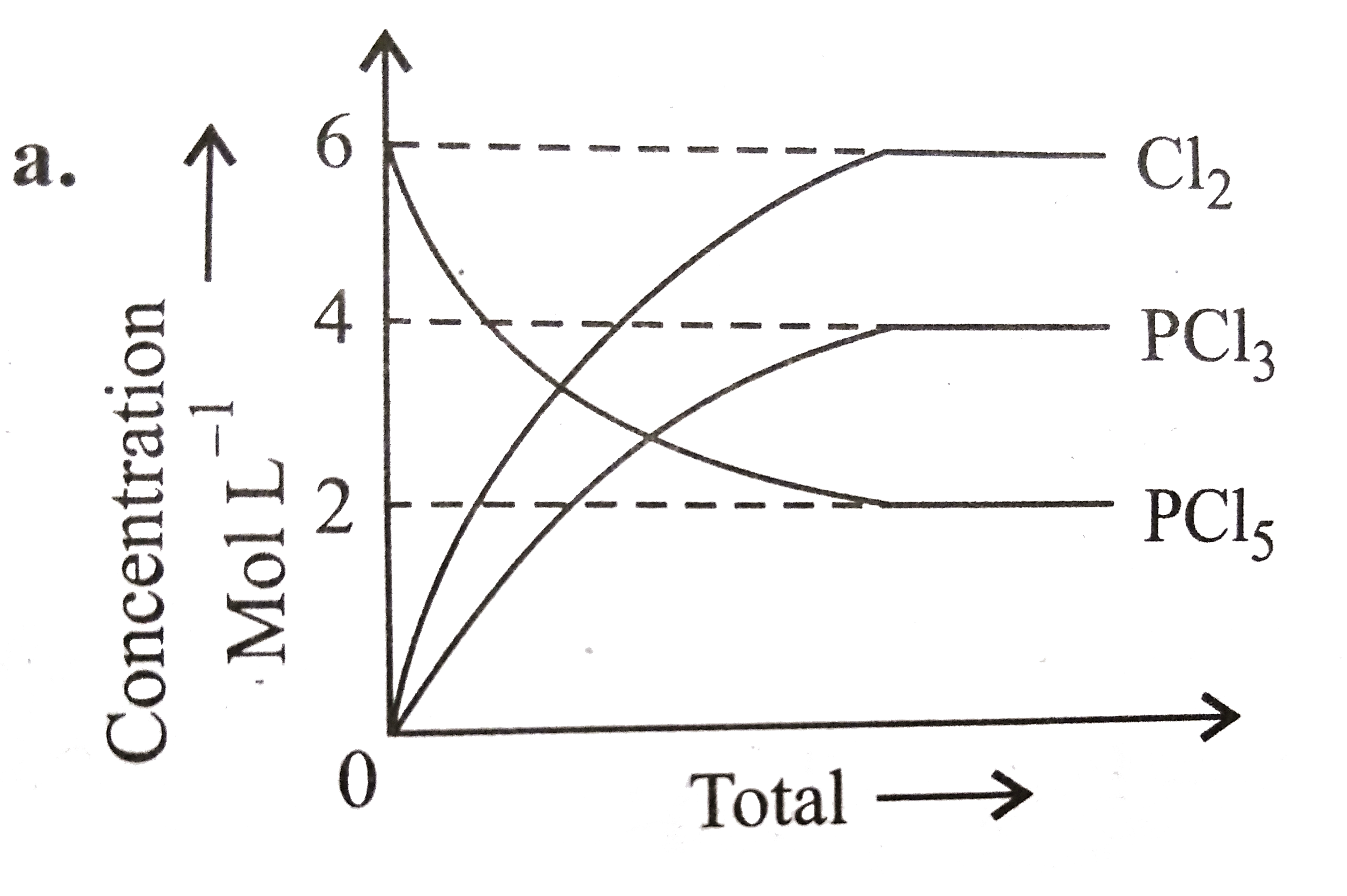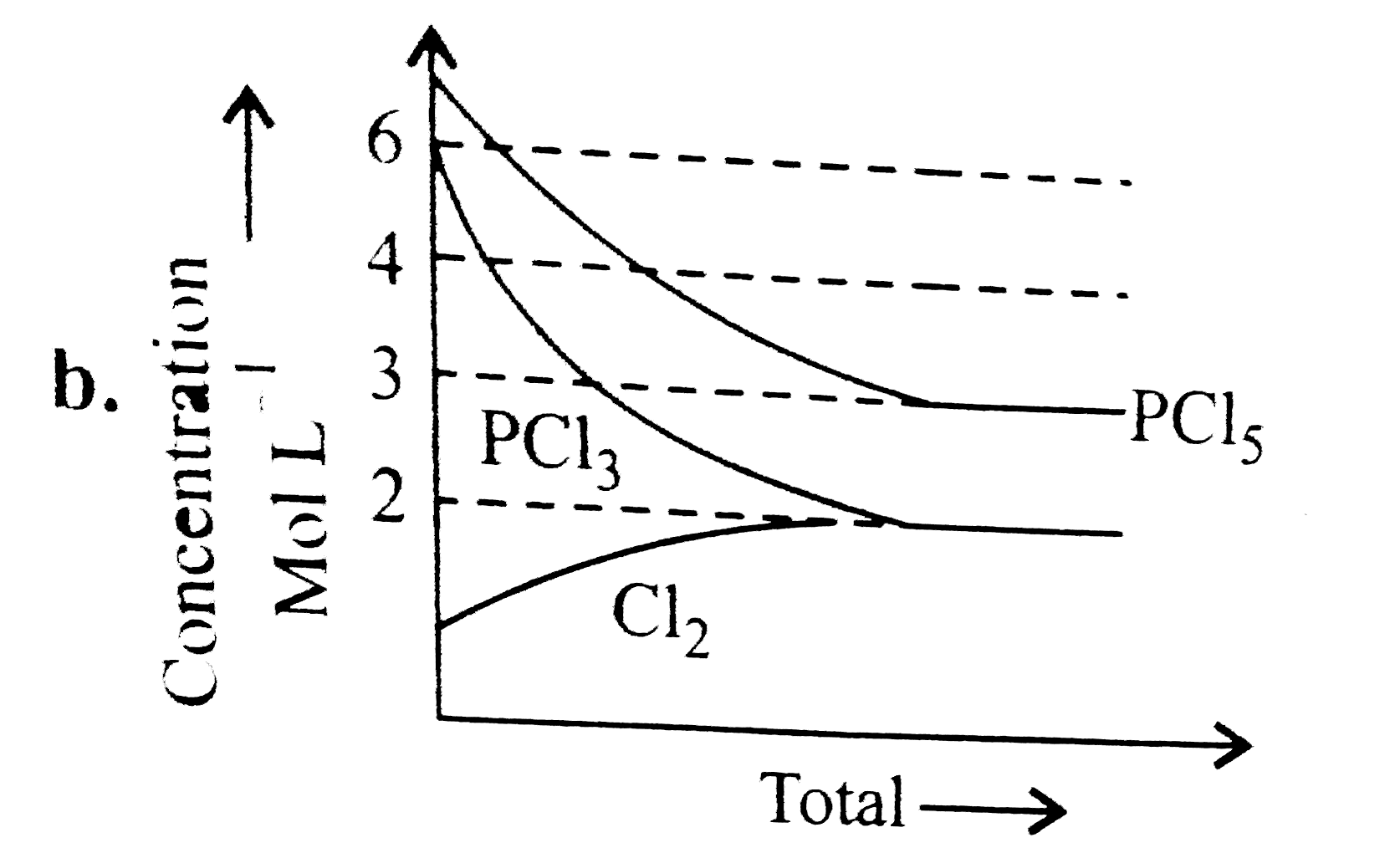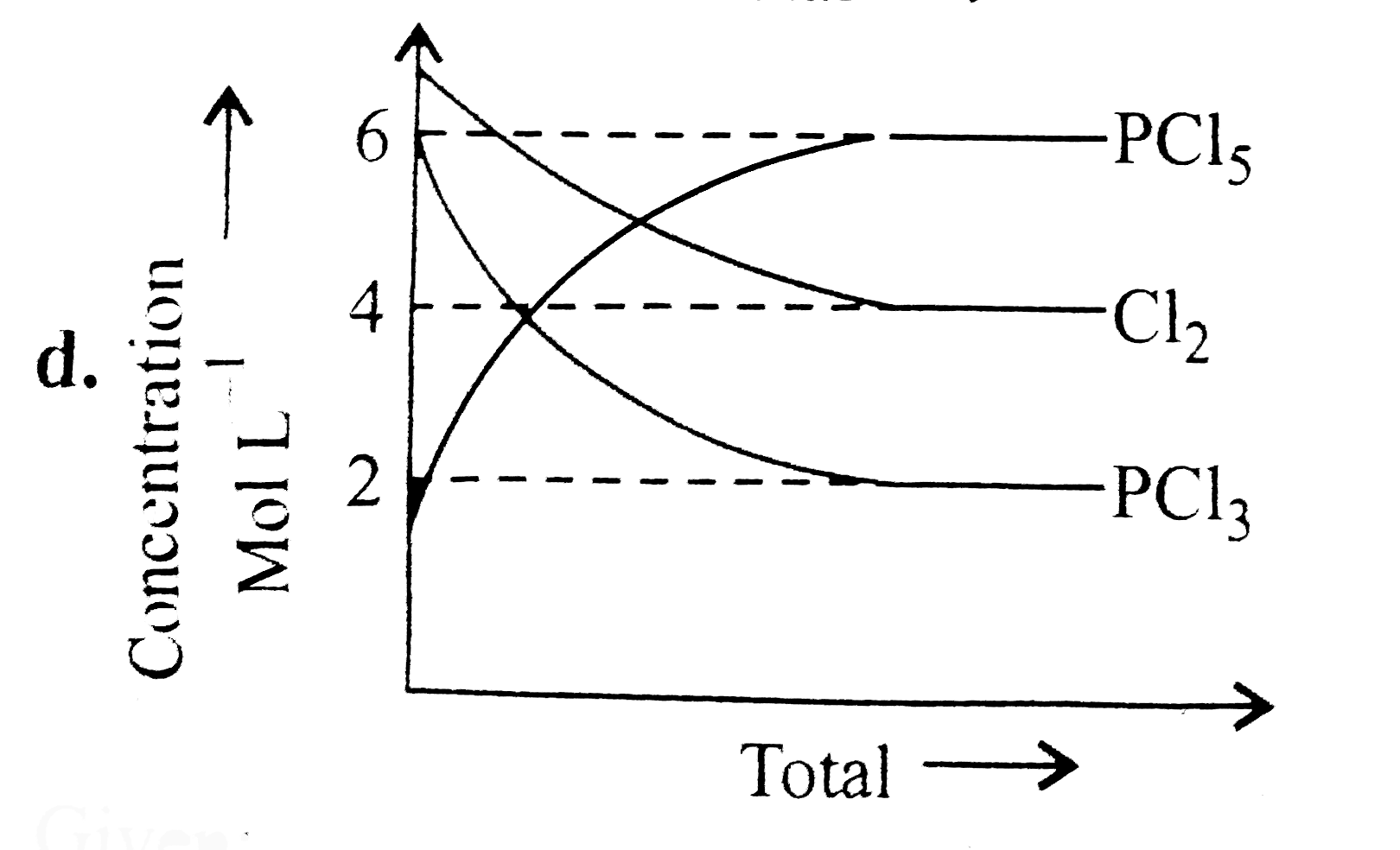For the reaction
PCl5(g)⇔PCl3(g)+Cl2(g)
Which of the following sketches may represent above equilibrium? Assume equilibrium can be achieved from either side and by taking any one or more components initially. Give Kc for the reaction <2?




To solve the problem regarding the equilibrium of the reaction PCl5(g)⇌PCl3(g)+Cl2(g) and to determine which sketch represents the equilibrium condition with Kc<2, we will follow these steps:
Step 1: Understand the Reaction
The reaction is:
PCl5(g)⇌PCl3(g)+Cl2(g)
This indicates that one mole of PCl5 dissociates into one mole of PCl3 and one mole of Cl2.
Step 2: Write the Expression for Kc
The equilibrium constant Kc for the reaction is given by:
Kc=(PCl3)(Cl2)(PCl5)
Where (PCl3), (Cl2), and (PCl5) are the concentrations of the respective species at equilibrium.
Step 3: Analyze Each Sketch
We need to evaluate each sketch provided in the question to see which one represents the equilibrium condition with Kc<2.
1. Sketch A:
- Assume concentrations are (PCl3)=4, (Cl2)=6, and (PCl5)=2.
- Calculate Kc:
Kc=(4)(6)2=242=12
- Since Kc=12 (greater than 2), this sketch is eliminated.
2. Sketch B:
- Assume concentrations are increasing for both (PCl3) and (Cl2) while (PCl5) is decreasing.
- This cannot represent equilibrium because at equilibrium, concentrations should stabilize, not continuously increase or decrease. Thus, this sketch is eliminated.
3. Sketch C:
- Assume initial concentrations are (PCl3)>6 and (Cl2) is between 4 and 6, with (PCl5)=0 at t=0.
- If (PCl3) is greater than 6, then as PCl5 forms, the concentrations will not stabilize correctly, leading to contradictions. Thus, this sketch is eliminated.
4. Sketch D:
- Assume concentrations are (PCl3)=2, (Cl2)=4, and (PCl5)=6.
- Calculate Kc:
Kc=(2)(4)6=86≈1.33
- Since Kc=1.33 (less than 2), this sketch represents the correct equilibrium condition.
Conclusion
The correct sketch that represents the equilibrium condition for the reaction PCl5(g)⇌PCl3(g)+Cl2(g) with Kc<2 is Sketch D.
The reaction is:
PCl5(g)⇌PCl3(g)+Cl2(g)
This indicates that one mole of PCl5 dissociates into one mole of PCl3 and one mole of Cl2.
The equilibrium constant Kc for the reaction is given by:
Kc=(PCl3)(Cl2)(PCl5)
Where (PCl3), (Cl2), and (PCl5) are the concentrations of the respective species at equilibrium.
We need to evaluate each sketch provided in the question to see which one represents the equilibrium condition with Kc<2.
- Assume concentrations are (PCl3)=4, (Cl2)=6, and (PCl5)=2.
- Calculate Kc:
Kc=(4)(6)2=242=12
- Since Kc=12 (greater than 2), this sketch is eliminated.
- Assume concentrations are increasing for both (PCl3) and (Cl2) while (PCl5) is decreasing.
- This cannot represent equilibrium because at equilibrium, concentrations should stabilize, not continuously increase or decrease. Thus, this sketch is eliminated.
- Assume initial concentrations are (PCl3)>6 and (Cl2) is between 4 and 6, with (PCl5)=0 at t=0.
- If (PCl3) is greater than 6, then as PCl5 forms, the concentrations will not stabilize correctly, leading to contradictions. Thus, this sketch is eliminated.
- Assume concentrations are (PCl3)=2, (Cl2)=4, and (PCl5)=6.
- Calculate Kc:
Kc=(2)(4)6=86≈1.33
- Since Kc=1.33 (less than 2), this sketch represents the correct equilibrium condition.
The correct sketch that represents the equilibrium condition for the reaction PCl5(g)⇌PCl3(g)+Cl2(g) with Kc<2 is Sketch D.
Topper's Solved these Questions
- CHEMICAL EQUILIBRIUMBOOK - CENGAGE CHEMISTRY ENGLISHCHAPTER - CHEMICAL EQUILIBRIUMEXERCISE - Concept Applicationexercise 7.1
53 Videos
- CHEMICAL EQUILIBRIUMBOOK - CENGAGE CHEMISTRY ENGLISHCHAPTER - CHEMICAL EQUILIBRIUMEXERCISE - Ex 7.2
40 Videos
- CHEMICAL BONDING AND MOLECULAR STRUCTUREBOOK - CENGAGE CHEMISTRY ENGLISHCHAPTER - CHEMICAL BONDING AND MOLECULAR STRUCTUREEXERCISE - Archives Subjective
15 Videos
- CLASSIFICATION AND NOMENCLATURE OF ORGANIC COMPOUNDSBOOK - CENGAGE CHEMISTRY ENGLISHCHAPTER - CLASSIFICATION AND NOMENCLATURE OF ORGANIC COMPOUNDSEXERCISE - Analytical and Descriptive Type
3 Videos
Similar Questions
Knowledge Check
For the reaction : PCl5(g)→PCl3(g)+Cl2(g):
A(a) Equal volumes of PCl5,PCl3andCl2 are present.B(b) Equal masses of PCl5,PCl3andCl2 are present.C(c) The concentrations of PCl5,PCl3andCl2 become constant.D(d) Reaction stopsFor the reaction,
PCl5(g)⇔PCl3(g)+Cl2(g), the forward reaction at constant temperature is favoured by:Aa. introducing an inert gas at constant volumeBb.introducing Cl2 at constant volumeCc. introducing PCl5 at constant volumeDd. reducing the volume of the container.
For the gas phase reaction
PCl5→PCl3(g)+Cl2(g)
which of the following conditions are correct?
View SolutionFor the reaction PCl5(g)⇔PCl3(g)+Cl2(g) the forward reaction at constant temperature is favoured by
View SolutionFor the reaction PCl5(g)⇔PCl3(g)+Cl2(g), the forward reaction at constant temperature favorrd by :
View SolutionFor PCl5(g)⇔PCl3(g)+Cl2(g), write the expression of Kc
View SolutionFor the reaction PCl5(g)⇔PCl3(g)+Cl2(g), the equation connecting the degree of dissociation (α) of PCl5(g) with the equilibrium constant Kp is
View SolutionIn the dissociation of PCl5 as
PCl5(g)⇔PCl3(g)+Cl2(g)
If the degree of dissociation is α at equilibrium pressure P, then the equilibrium constant for the reaction is
View Solution
